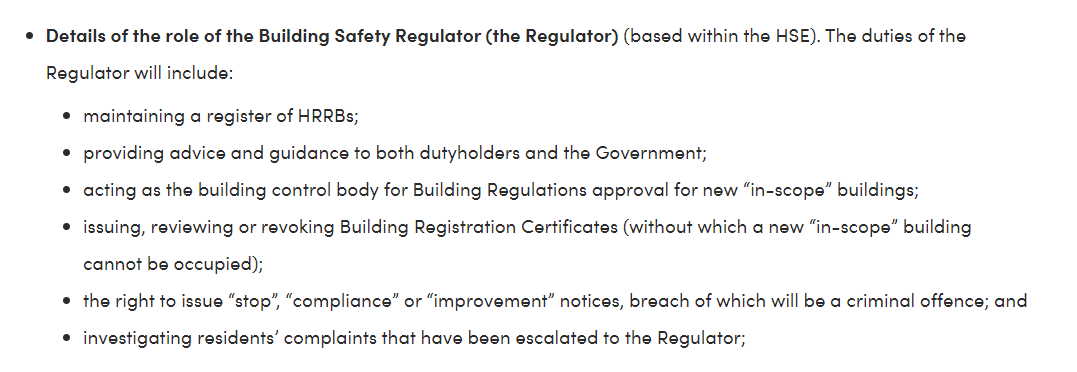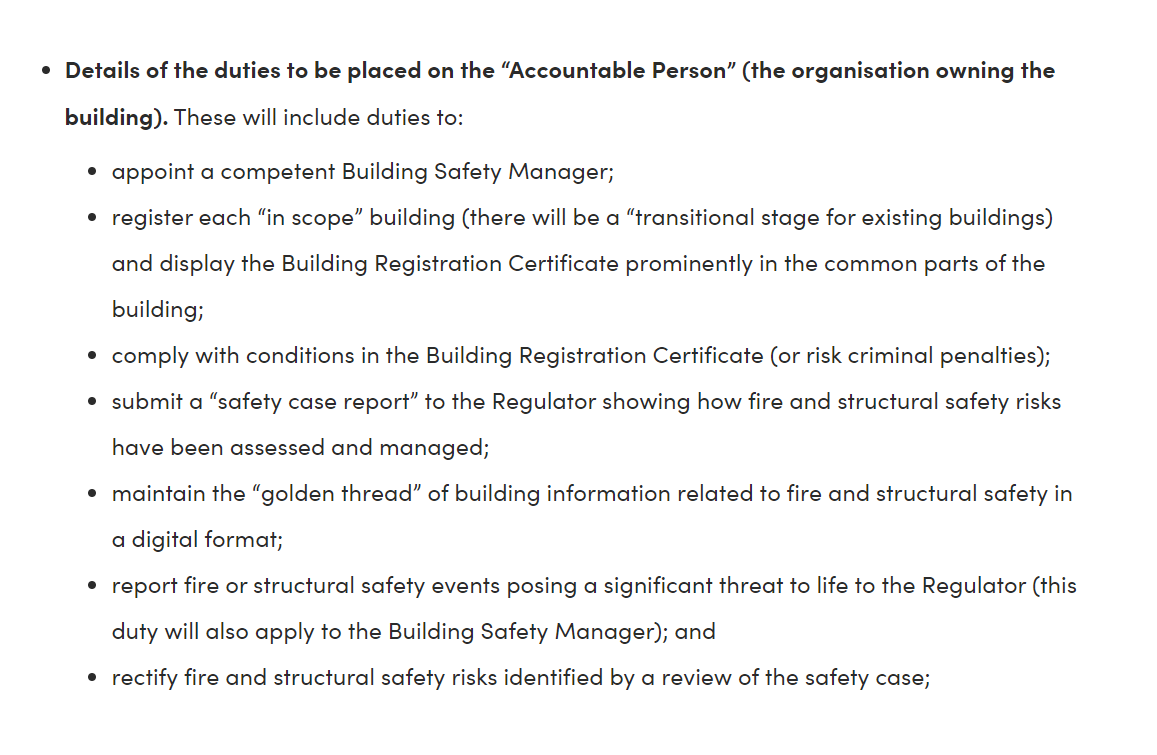
| 11 May 2020
It’s been just under three years since the devastating event, a not-so-distant memory and a horror scene very much visible in West London today. Government response to Grenfell has come in endless forms: reviews, reports, consultations and yet, real action, has been noticeably slow.
In 2018, the government ordered an independent review of fire safety management in England and Wales, which was led by Dame Judith Hackitt. The findings shed light on the ultimately damning reality – that the existing fire safety programme in high-rise properties is ‘not fit for purpose’ – frankly, this was an understatement.
“I have been shocked by some of the practices and I am convinced of the need for a new intelligent system of regulation and enforcement for high-rise and complex buildings which will encourage everyone to do the right thing and will hold to account those who try to cut corners.” – Dame Judith Hackett
Over 400 high-rise blocks were identified as having unsafe aluminium composite material (ACM), a type of external cladding, similar to that which failed at Grenfell Tower with cataclysmal effect.
Combustible materials ban
The Building a Safer Future report, which summarised Hackitt’s findings, was followed by a national ban on the use of combustible materials (21 December 2018) – i.e. AMC cladding – in high-rise residential buildings. Along with this, came a proposal for a new building safety regulator, however, although welcome, this just wasn’t enough.
In a consultation reviewing the Approved Document B (the statutory guidance on fire safety matters within and around premises), architecture body RIBA urged the government to implement the recommendations they and others in the industry have long been calling for.
The built environment and security industries, backed by MPs, pushed for further amendments, insisting that “stronger prescriptive guidance” was needed. Along with this, they demanded an end to the use of ‘desktop studies’ (a study carried out purely through research, rather than physical investigations) to certify fire safety compliance.
When a large number of people are affected by one tragedy it poses challenges for policymaking. The government has to be seen to react to high-profile events; this can result in ‘kneejerk legislation’, rushed and poorly thought through.
How does this affect healthcare?
Amongst the most striking discrepancies found in the reforms, was that they only applied to residential blocks over 18m. What’s more, the height threshold for sprinklers was still only mandated for properties 30m and higher. This effectively left thousands of residential properties and other high-risk buildings including schools, medical facilities and care homes still at risk.
We have discussed before the added burden of fire risks in medical and care facilities. The vulnerability and immobility of patients/residents, along with the sheer number of people employed in them, means fire protection is a serious concern.
Figures from NHS Digital reported that false alarm incidents in the NHS have risen by 12% over five years. There was at least one false alarm incident every fortnight at Dartford and Gravesham NHS Trust in 2017-18. In 2014, the top 10 worst offenders racked up £177,000 in fines, with the NHS facing a six-figure bill in the capital due to false alarm call-outs.
Most false alarms caused by badly maintained systems or things like burnt toast. Likewise, some of these incidents will have been caused by a worker, employed by a sub-contractor, who failed to follow proper procedures during maintenance work on the system. They also need to be held accountable.
The increasing problem is costing “thousands of staff hours”, according to the National Fire Chief’s Council (NFCC) and could also pose a serious risk to the safety of patients and staff due to complacency.
“False fire alarm activations cause huge problems for the NHS, the fire and rescue services. Every year, thousands of staff hours are lost, affecting both fire and health service delivery, business continuity and patient care.” – Paul McCourt, NFCC
As of April 2021, this bill has now passed the parliamentary process and become The Fire Safety Act.
The new regime
After much waiting and substantial activism pushing for more to be done, on April 2nd (a year and a half after the original reforms), the government released a major update – one which housing secretary, Robert Jenrick has described as “the biggest change in building safety for a generation”.
Changes implemented to “go faster and further to promote fire safety” include an extension of the combustible materials ban, lower mandatory sprinkler limits, installation of wayfinding signage and a new BSR (a building safety regulator with powers to enact harsher penalties for malpractice).
The Building a Safer Future consultation, launched in June last year, was finally brought to a close on 17 February, with measures implemented as of May.
Need more info? Us too, so here’s our breakdown of what’s to come…
Lower thresholds
The meaning of high-risk has rightly been put into question and as a result, the criteria for which higher-risk residential buildings (HRRBs) get special attention has (ever so slightly) shifted.
Whilst the new regime and BSR was to only apply to constructions above 18m high, now it will also include blocks under that threshold but (and it’s a big but) only those that are six storeys or more. They added that measures would “in due course, extend to include other premises, based on emerging risk evidence”. Let’s hope ‘in due course’ doesn’t mean another two years.
They have also announced that replacement of high-rise cladding with superior fire protection should continue during the Covid-19 pandemic as this is “critical to fire safety and a top priority”. The show goes on!
The sprinkler height limit, contrarily, saw a more radical reform. Mr Jenrick confirmed that from May, the Ministry of Housing, Communities and Local Government would ‘effectively ensure’ sprinkler installations in all residential blocks above 11m in height, along with improved and consistent wayfinding signage to help residents evacuate in a fire.
The move means an estimated 15,940 new properties will be fitted with sprinklers over 10 years, some of which will include care homes, supported housing, clinics and other healthcare facilities.
The BSR

In July of this year, the government shared a draft of the “Building Safety Bill.” This outlines their plans to enhance the structural safety of residential buildings. The bill is currently being discussed in parliament. It is expected to take full effect in 2023, but some sections are set to become law from August 2021.
This new bill will be policed by the BSR, and applies to buildings above six storeys. They will keep tabs on major decisions made during the construction and refurbishment phases. They have the power to inspect any refurbishments, ceasing any unsafe works if deemed necessary, whilst ensuring residents have better access to information about the safety of their current homes.
The duties of the new BSR has been allocated to the Health and Safety Executive (HSE), the government agency responsible for researching and enforcing occupational safety – and now with beefed-up powers to enact prosecutions where fire safety regulations are flouted.
It’s safe to say, however, not as beefed up as one may like. Initially, in her landmark report back in 2018, Judith Hackitt had called for the new BSR to be overseen jointly by the HSE, as well as the local authority building control, fire and rescue services. Considering the HSE is already facing significant resourcing pressures, it begs the question – how effective can the BSR really be without effective funding? Clarity on this is yet to be shared.
In my view, the new regulator and its inspectors will not have the manpower to investigate and eradicate all bad practice out there.
Ian King, Zeroignition
A culture of accountability
The regime will include greater scrutiny of roles and responsibilities, as well as the establishment of a new role of “accountable person”, who it is envisaged will be legally responsible for the fire and structural safety of an occupied residence.
The Fire Safety Bill (revised in March, from the Fire Safety Order 2005) now states that the responsible person or duty-holder for multi-occupied, residential properties must manage and mitigate the risk of fire for the structure and external walls, including cladding, balconies and windows as well as entrance doors to individual flats that open into common areas. The regulatory reform will see a new system of duty-holders with clear responsibilities at each stage of a building’s life-cycle.
During the design, construction and management process, the five duty holders mirror those under the 2015 CDM Regulations – the Client, Principal Designer, Principal Contractor, any Contractor and any Designer (anyone who prepares or modifies the design). Once the planning, design and construction phases are finalised and duty holders have signed a final declaration confirming that, to the best of their knowledge, it is fire safety compliant, the new build has passed what is now called the ‘three gateways‘.
Once gateway three has been passed, prior to occupation, responsibility will be passed over to the ‘Accountable Person’. They will be responsible for managing risk assessments of the property once inhabited, taking the appropriate steps to mitigate any fire or structural risks.
The comprehensive fire risk assessment requires identifying and evaluating potential hazards and at-risk persons, deciding on necessary controls and mitigation measures, whilst recording and monitoring the risks on an ongoing basis.

Likewise, residents are prohibited from removing compliant fire doors or making any structural alterations that may compromise fire safety. On the flip side, residents now have the right to obtain information about their home’s fire safety.
A Building Safety Bill, which will provide clearer accountability and stronger duties on those responsible for high rise blocks, is set to be introduced later this year.
Concerns
These regulations are now imminent but the worry is that legislation alone will not combat the systemic problems, the ‘cutting corners’ approach seen too often, that the construction industry harbours. Hopefully, the new emphasis on roles will foster a new sense of accountability and ownership of risk, however, some would say such roles are just as vulnerable to falling into the current fragmented system we are running from.
Ian King, CEO of Zeroignition Technologies, the ‘future of fire protection’, speculates that the new regime is purely on paper and won’t be enforced.
I want to understand how the government plans to make the industry adhere to these regulations…positive regulation of safety is great, but only if it is policed.
Ian King
His concerns aren’t unfounded. Speaking at a conference for the construction products manufacturing industry in February, Dame Judith Hackitt stated that “there’s not enough change, there’s a lack of leadership, there’s a lack of real drive and collective commitment to make this happen”.
“People are playing games with the system with profit margins prioritised over protecting lives.” Dame Judith Hackitt
Lord Gary Porter, building safety spokesperson for the Local Government Association (who have long called for sprinklers in new blocks to be lowered) voiced his concern that the scope of the new regime is too easy to cheat, referencing constructions that have been “built just below a height of 18m, specifically to game the system and dodge safety standards.”.
They are also concerned that residents of existing properties will be far worse off than those in new properties; insisting that the government should fund the retrofitting of sprinklers in existing blocks of flats, once the current crisis is over.
In an interview with Westminster Briefing, the chair of the Independent Advisory Panel on building safety had a slightly different sentiment that, depending on how sceptical you are, could offer some food for thought:
“ Learning the lessons from the tragedy at Grenfell and avoiding it happening again can’t purely be a matter for Government. Instead, every organisation and professional body has a key part to play to fix the failures. To do so, everyone has a responsibility to understand the (now well-identified) changes required and engage with their respective organisations to implement them…” Sir Ken Knight
Our verdict
Some will resent such optimism and the imagery it evokes – a utopia where every cog in the machine does it’s part and abides by the laws of the land. Yet, the law depends on a system of compliance that, in most parts, works. There are people that will try their very best to cheat the system, there always has been and there always will. But, tighter regulation has always brought that number down – not eradicated it but hindered it.
It’s also safe to say that nobody, no matter how loosely they follow the law, wants something like Grenfell to happen again. And for the majority of us that don’t, these changes are a massive step in the right direction for fire safety legislation. Like most situations involving more than one human being, communication is key.
What’s next?
- Approved Document B (Building Regulations guidance on Fire Safety Standards), of which a “clarified” version was issued in summer 2019, will be reviewed and updated in May 2020
- Testing carried out on other types of cladding including high-pressure laminate demonstrated that they were not as combustible as the aluminium composite material (ACM) used on Grenfell Tower
- New evacuation alert system technology is being tested by the National Fire Chiefs Council, with a view to making a further update to Approved Document B in the future
- The Fire Safety Bill is set to be discussed at a parliamentary level. Once passed, it will be a legal requirement to follow it. (Update: from April 2021, this bill has now passed and is the Fire Safety Act.)
- A Building Safety Bill, which will provide clearer accountability and stronger duties on those responsible for HRRBs, is set to become in full effect in 2023, with some aspects being implemented from as early as August 2021.. In addition, the BSR is currently being set up in shadow form by the Health and Safety Executive
- The consultation reforms are expected to cost between £266m and £530m a year in total, offset by benefits worth between £190m and £380m a year including through avoiding fires causing multiple deaths
- A £1bn fund for removing unsafe cladding from high rises will be available to private and social sector landlords in 2020/2021 – a prospectus on the programme is set for publication in May, open for registrations “soon after that”. (Update: in February 2021, the government increased this fund to £5bn).
Fire Safety: 2021 Update
Since this article was published, there have been several changes to the legislation and bills mentioned. To name a few:
- After being rejected five times, the Fire Safety Bill passed the parliamentary process and became law. The Fire Safety Act came into effect from April 2021.
- The Building Safety Bill, though still in draft form, has started to take effect. From the 1st of August 2021, all building developments must pass “Gateway One” and be approved by a Building Safety Regulator. The remainder of the bill still needs to pass through parliament and is set for 2023 at the latest.
- The government has invested more into removing unsafe cladding – taking the total up to £5 billion. From February 2021, the government will cover the cost on all high-risk buildings.
These new updates impact your legal obligations and rights.
Regardless of who you are, you must equip yourself with the skills and knowledge to pass requirements and manage fire risks.
eLearning for healthcare
Unlock your potential – our healthcare eLearning courses make it simple to access high quality content, that deliver on your statutory and mandatory training and compliance needs.
